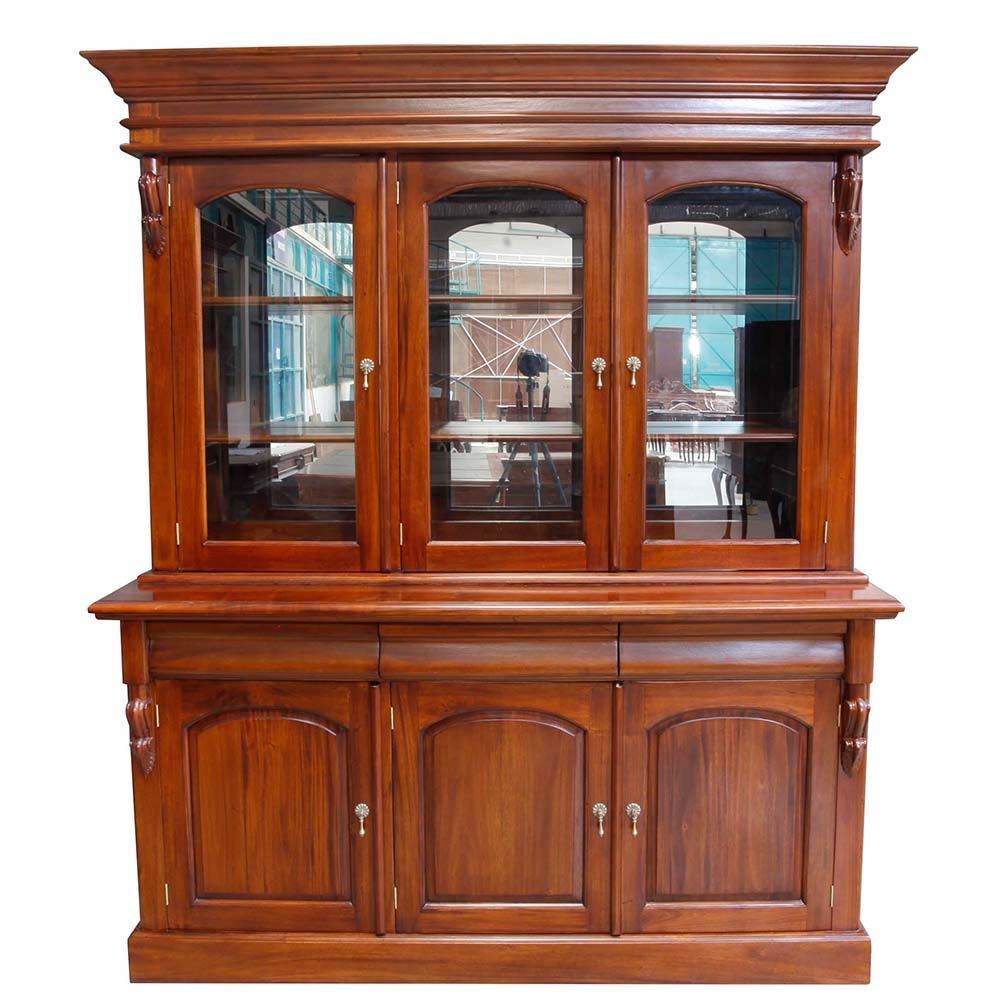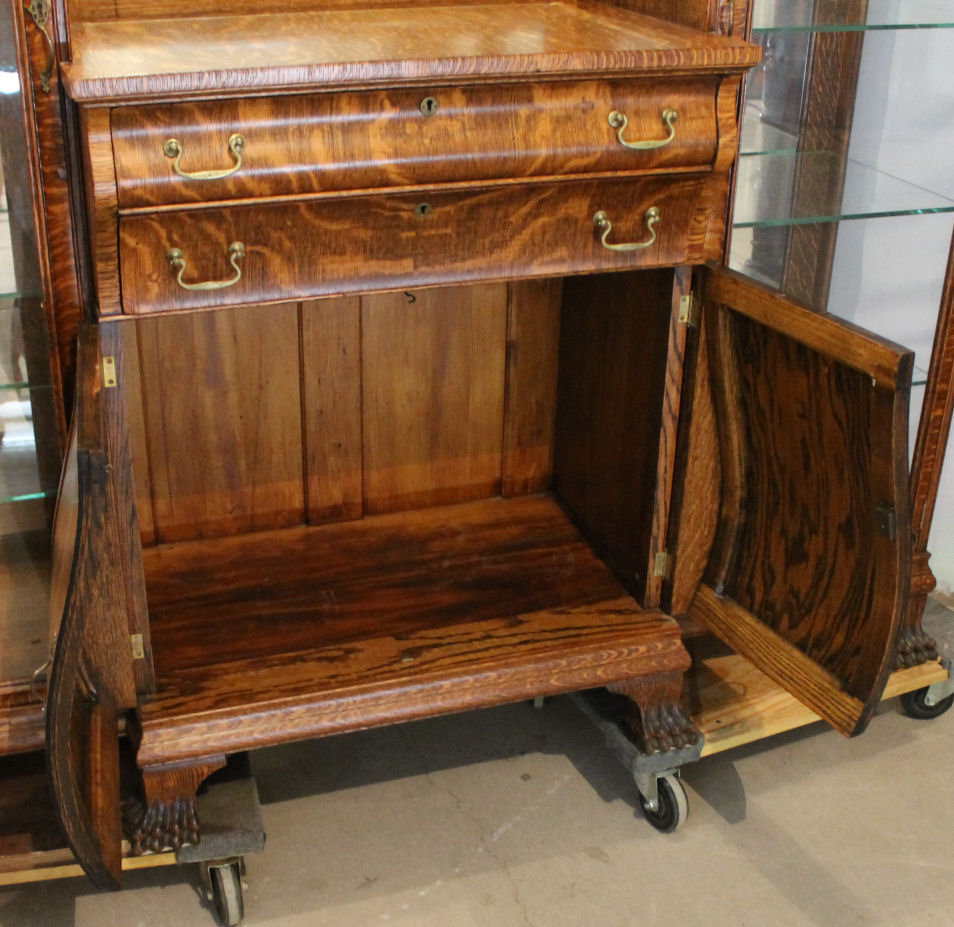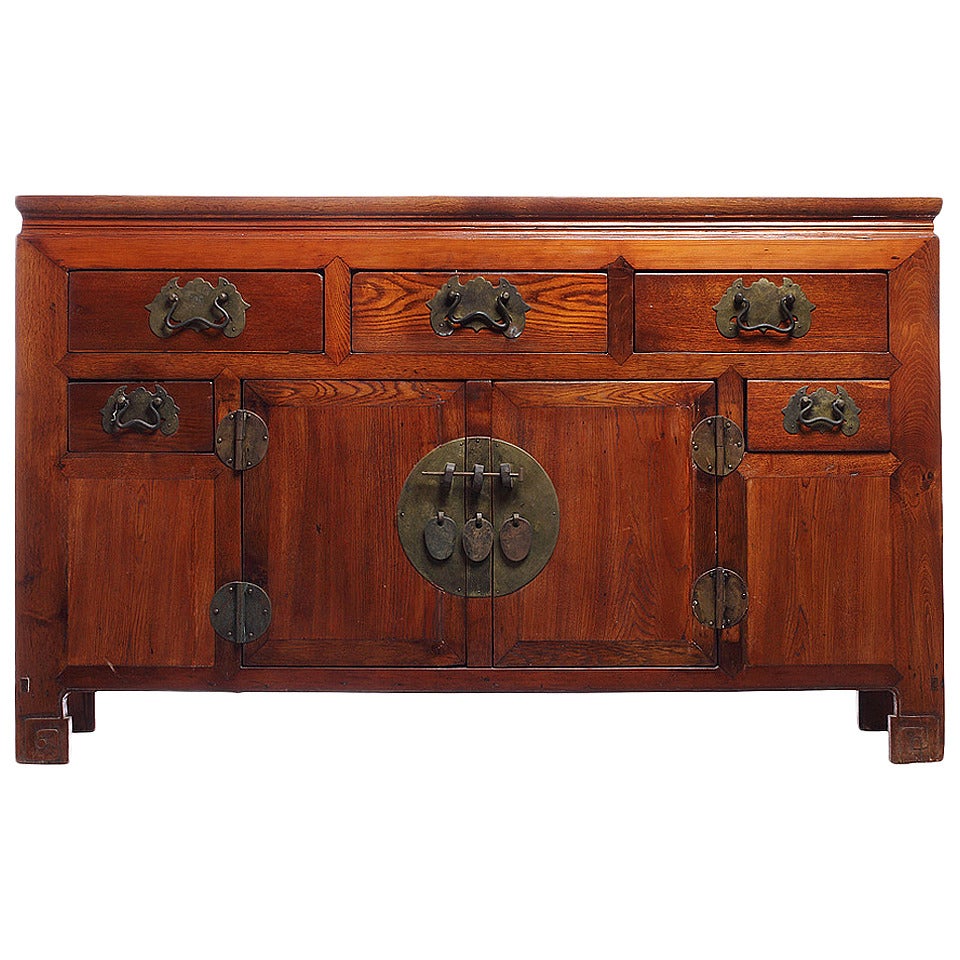History and Styles of Antique China Cabinets and Buffets: Antique China Cabinet And Buffet

Antique china cabinets and buffets have been a staple in homes for centuries, evolving alongside changing tastes and trends. From the simple storage solutions of the past to the elaborate statement pieces of today, these pieces have a rich history that reflects the craftsmanship and cultural values of their time.
Early Origins and Evolution
The earliest forms of china cabinets and buffets emerged in the 17th century, serving as practical storage solutions for valuable porcelain and glassware. These early pieces were often simple in design, featuring a basic cabinet with shelves or drawers. As the 18th century progressed, the demand for more elaborate and decorative furniture increased, leading to the development of more ornate styles. The use of exotic woods, intricate carvings, and gilded accents became common, reflecting the growing wealth and sophistication of the upper classes.
Popular Styles of Antique China Cabinets and Buffets
Throughout history, numerous styles of china cabinets and buffets have emerged, each reflecting the aesthetic preferences and cultural influences of its era. Here are some of the most popular styles:
Georgian Style (1714-1830)
The Georgian era was characterized by a preference for symmetry, balance, and classical forms. Georgian china cabinets and buffets often featured simple, elegant lines, with intricate carvings and delicate veneers. They were typically made from mahogany or walnut, and often incorporated brass hardware.
“The Georgian style was a period of great elegance and refinement, and this is reflected in the design of the china cabinets and buffets of the era.”
Victorian Style (1837-1901)
The Victorian era was a time of great opulence and extravagance, and this is reflected in the design of Victorian china cabinets and buffets. These pieces were often highly ornate, featuring elaborate carvings, intricate inlays, and a wide range of decorative elements. They were typically made from a variety of woods, including mahogany, rosewood, and walnut.
“Victorian china cabinets and buffets were designed to impress, and they often featured elaborate carvings, intricate inlays, and a wide range of decorative elements.”
Art Nouveau Style (1890-1910)
The Art Nouveau style was a reaction against the heavy ornamentation of the Victorian era. It emphasized organic forms, flowing lines, and natural motifs. Art Nouveau china cabinets and buffets often featured curved lines, floral patterns, and intricate metalwork. They were typically made from exotic woods, such as mahogany and rosewood.
“Art Nouveau china cabinets and buffets were designed to be both functional and beautiful, with a focus on organic forms and natural motifs.”
Art Deco Style (1920s-1930s)
The Art Deco style was characterized by geometric shapes, bold colors, and luxurious materials. Art Deco china cabinets and buffets often featured geometric patterns, stylized animal motifs, and metallic accents. They were typically made from exotic woods, such as ebony and rosewood, and often incorporated glass and metal elements.
“Art Deco china cabinets and buffets were designed to be both stylish and functional, with a focus on geometric shapes, bold colors, and luxurious materials.”
Mid-Century Modern Style (1940s-1960s)
Mid-century modern china cabinets and buffets were characterized by clean lines, simple forms, and a focus on functionality. They were typically made from materials such as teak, walnut, and rosewood, and often featured minimalist designs with a focus on natural materials.
“Mid-century modern china cabinets and buffets were designed to be both stylish and functional, with a focus on clean lines, simple forms, and a focus on functionality.”
Identifying and Appraising Antique China Cabinets and Buffets

Identifying and appraising antique china cabinets and buffets is a bit like deciphering a historical puzzle. It requires an understanding of construction techniques, materials, markings, and the historical context of the piece. With a keen eye and a little knowledge, you can uncover the secrets of these treasured pieces.
Identifying Authentic Antique China Cabinets and Buffets
To spot a genuine antique, look for clues in the construction, materials, and markings.
- Construction Techniques: Authentic antique cabinets often feature dovetail joints, mortise and tenon joints, and hand-cut details. These techniques were common in the past and are often a sign of craftsmanship.
- Materials: Look for solid wood construction, particularly hardwoods like oak, mahogany, or walnut. Avoid pieces with veneer or particleboard, which are more likely to be modern reproductions.
- Markings: Pay attention to labels, stamps, or inscriptions on the piece. These can reveal the maker, date of manufacture, or even the original owner.
Determining the Age and Provenance of Antique China Cabinets and Buffets
The age and provenance of an antique can significantly impact its value.
- Style and Design: The style and design of the cabinet can be a good indicator of its age. For example, a cabinet with Queen Anne legs is likely from the early 18th century.
- Hardware: The type of hinges, handles, and other hardware can also provide clues about the age of the piece. Look for hand-forged or cast iron hardware, which is more common in older pieces.
- Wood: The type and condition of the wood can also offer insights into the age of the cabinet. Look for signs of aging, such as patina, wear, and discoloration.
Factors Influencing the Value of Antique China Cabinets and Buffets
The value of an antique china cabinet or buffet is determined by a combination of factors.
- Rarity: A rare piece, such as a cabinet by a renowned maker or one with a unique design, will generally command a higher price.
- Condition: The condition of the piece is also crucial. A cabinet in excellent condition, with minimal wear and tear, will be more valuable than one that has been damaged or restored.
- Historical Significance: A piece with a strong historical connection, such as a cabinet that belonged to a famous person or was used in a significant event, will be highly sought after by collectors.
Common Antique China Cabinet and Buffet Finishes
Antique cabinets often feature unique finishes that contribute to their overall appeal.
- Paint: Antique cabinets can be painted in various colors and styles, such as milk paint, oil-based paint, or even hand-painted designs.
- Stain: Stains are used to enhance the natural beauty of the wood, giving it a rich color and depth. Common stains include walnut, mahogany, and cherry.
- Varnish: Varnish is applied to protect the wood and create a glossy or matte finish. Antique cabinets may have several layers of varnish, which can create a beautiful patina over time.
Caring for and Displaying Antique China Cabinets and Buffets

These timeless pieces deserve TLC to ensure they stay looking their best and last for generations to come. Caring for an antique china cabinet or buffet involves a few key steps to keep it looking its best.
Cleaning and Polishing
Cleaning and polishing your antique china cabinet or buffet regularly is essential for maintaining its beauty and preventing damage. Here’s what you need to know:
- Use a soft, damp cloth to dust the cabinet or buffet regularly. Avoid using harsh chemicals or abrasive cleaners, as these can damage the finish.
- For deeper cleaning, use a mild soap solution. Gently wipe the surface with a soft cloth and rinse thoroughly with clean water. Make sure to dry the cabinet or buffet completely to prevent water damage.
- Apply a furniture polish specifically designed for antique finishes. Apply the polish in a thin layer and buff it in with a soft cloth. Avoid using too much polish, as this can leave a sticky residue.
- Pay attention to the details. Use a small brush to clean the crevices and corners of the cabinet or buffet. This will help to remove dust and debris that can accumulate over time.
Storage and Environmental Conditions
The environment your antique china cabinet or buffet is stored in can significantly impact its longevity. Here’s what you need to know:
- Store your antique china cabinet or buffet in a cool, dry place. Avoid exposing it to direct sunlight, heat, or humidity, as these can cause damage to the wood and finish.
- Consider using a humidity control device, such as a dehumidifier, to regulate the moisture levels in the room. This will help to prevent warping, cracking, and other damage caused by fluctuating humidity.
- If you’re storing the cabinet or buffet for an extended period, wrap it in a breathable fabric cover to protect it from dust and dirt. Avoid using plastic covers, as these can trap moisture and lead to mildew.
Displaying Antique China Cabinets and Buffets, Antique china cabinet and buffet
Displaying your antique china cabinet or buffet in your modern home can add a touch of elegance and history. Here are some ideas:
- Choose a prominent location for your antique china cabinet or buffet. A hallway, dining room, or living room can be ideal spots to showcase its beauty.
- Consider the size and shape of the furniture when choosing a location. Ensure there is enough space around the cabinet or buffet for people to move around comfortably.
- Create a cohesive design aesthetic. Use the antique china cabinet or buffet as a focal point and choose other furniture and décor that complements its style.
- Highlight the beauty of the antique china cabinet or buffet by showcasing your finest china, glassware, or other collectibles. Consider using decorative lighting to enhance the display.
Layout for an Antique China Cabinet and Buffet Display
To create a stunning display for your antique china cabinet and buffet, consider the following layout:
- Place the china cabinet in a prominent location in the room, such as against a wall or in a corner.
- Position the buffet next to the china cabinet, creating a cohesive display. Ensure there is enough space between the two pieces for people to move around comfortably.
- Use the china cabinet to showcase your most valuable china and glassware. Arrange the items in a visually appealing way, using different heights and textures to create interest.
- Utilize the buffet for displaying other items, such as silverware, serving dishes, or decorative objects. You can also use the buffet as a surface for serving food or drinks.
- Add a touch of personality to the display by incorporating family heirlooms, vintage items, or other meaningful objects. This will help to create a unique and personal space.
Imagine an antique china cabinet and buffet, its polished wood reflecting the flickering candlelight. Each piece of delicate porcelain tells a story, whispers of grand dinners and formal gatherings. This sense of history and tradition echoes in the cabinet office board room a , where decisions are made that shape the future.
Just as the china cabinet holds cherished memories, the board room holds the weight of policy, a testament to the enduring power of both the past and the present.
The antique china cabinet and buffet, a testament to bygone elegance, whispers stories of formal dinners and cherished heirlooms. Yet, even in the realm of vintage grandeur, practicality reigns supreme. For those who seek a similar blend of aesthetic appeal and functional organization for their footwear, the sarmog double shoe cabinet offers a contemporary solution, marrying sleek design with ample storage space.
Just as the antique china cabinet and buffet once held the keys to a well-ordered home, the sarmog double shoe cabinet promises to keep your footwear collection tidy and easily accessible.
